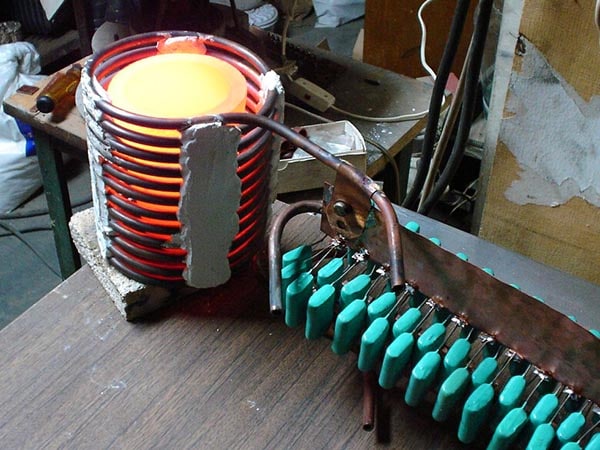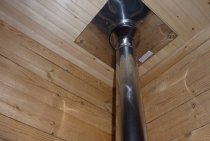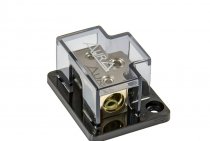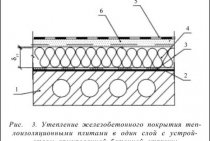Differences between a homemade and a factory unit
To understand the difference, you need to take the purpose of using the equipment as a starting point. Home assembly units are usually needed for periodic use (breaks can be significant), so the minimum cost, the ability to perform simple manipulations, and low maintenance requirements come to the fore.
In the event that the results of melting are used to earn money, it is more advisable to purchase a factory induction model - such equipment contributes to accurate work, helps to accurately observe measurements, and reduces the likelihood of unwanted impurities to zero. It is difficult to do the same equipment with your own hands - assembling an inductor, choosing a crucible , screen arrangement requires specialized skills. Not everyone can create a capacitor bank and a generator.
 Do-it-yourself crucible furnace
Do-it-yourself crucible furnace
Ergonomic indicators of furnaces should not be overlooked. In handicraft blanks, they are given a minimum of resources, as a rule, such variations are inconvenient to use, often dangerous due to the use of improvised materials. Proven technologies are used in the factory lines to ensure comfortable work, in particular, this concerns the configuration and the turning mechanism of the crucible
It is important that conditions are created in them to prevent injuries.
Lining of induction furnaces
Lining of induction furnaces - what is it and why is it carried out? It's very simple: the lining is necessary to protect the furnace shell from the harmful effects of high temperatures. Moreover, it allows to significantly reduce heat losses, which means to increase the efficiency of the entire process.
The lining material is usually quartzite (a modification of silica). In order for the lining to successfully fulfill all its functions, it is necessary to provide three zones of different material conditions: buffer, monolithic and intermediate. Only such a three-layer coating can fully implement the protective function.
What adversely affects the lining:
- incorrect styling;
poor quality of protective materials;
severe operating conditions
Coreless Induction Crucible Furnaces
Work
crucible induction furnace based
on the absorption of electromagnetic energy
conductive cage. The cage is placed
inside a cylindrical coil called
inductor.
Real
crucible induction furnaces have
loading mechanism - unloading and system
water-cooled inductor.
Furnace crucible on
melting time is covered with a lined
lid. Sometimes the furnace is supplied with external
magnetic circuits that reduce active
losses in the metal casing due to
scattering. From an electrical point of view,
crucible induction furnace introduces
a short-circuited air
transformer, secondary winding
which is a conductive cage.
This embodiment of the furnace has some
technological advantages:
-
Immediate
release of thermal energy of the conductive
cage increases the efficiency of the installation, allows
get the high temperatures needed
for smelting refractory metals. -
Metal in the crucible
intensively mixed thanks to
electrodynamic interaction
electromagnetic field of the inductor and
eddy currents in liquid metal. This
allows you to get high-quality metal
quality. -
There is a possibility
completely isolate the crucible from
environment and carry out melting
under vacuum or special, necessary
atmosphere technology (inert
gases).
These benefits
are implemented to a greater extent
iron smelting. However, the construction
furnace in the form of an air transformer
has disadvantages:
-
These transformers
more effective at high and elevated
frequencies. This forces many
cases to feed crucible furnaces from
power supplies operating in
range from 500 to 10000 Hz. -
Significant
air transformer leakage
causes a very low value of cos
(0,05 – 0,2),.
Such a low value of cos
makes
both at a frequency of 50 Hz and at elevated
frequencies use capacitive
reactive power compensation in
inductor circuits. crucible furnace together
with parallel compensation tank
often represented as parallel
connected active, inductive
and capacitance.
xL,
R - resistance
inductor-saddle systems.
xC
– capacitive
compensation battery resistance.
Quantities
xL,
R in
largely dependent on the mode
oven operation. They are influenced
sedimentation, sintering, batch melting,
temperature in the crucible, sizes of pieces
charge, the uniformity of its grinding and
others
t1:
heat
solid charge up to the Curie point is such
the point at which the magnetic
properties of a ferromagnet.
t2:
further
heating the charge that has lost its magnetic
semi-melting properties.
Significant
change in system resistance
the inductor-charge during melting leads
to significant fluctuations in the active and
reactive power consumed
oven. This forces you to use
automatic mode control
oven operation.
Do-it-yourself crucible furnace step by step instructions
If you have to periodically melt up to 3 kg of scrap, the performance of the unit, built of oven bricks, will be sufficient.
Materials and technology
It is necessary to prepare:
- 20-25 red bricks;
- grill grate;
- electrical tape;
- hair dryer and a piece of pipe suitable for the diameter of its nozzle;
- a tin can with high thick walls;
- steel wire;
- coal (needed for ignition).
Bricks are laid in the base of the body, they serve as fireproof protection of the unit. The crucible in this case is a tin can, on opposite sides of its upper part 2 holes are made and steel wire is passed through them. This makeshift handle will help you pull the alloy container out of the oven.
To supply air, home craftsmen use a hairdryer turned on in the “cold” mode, a piece of pipe is wound to it with electrical tape, the design turns into an impromptu air duct.
The scheme of such a crucible furnace for melting aluminum is extremely simple, it can be performed without specific skills. Zinc-coated consumables must not be used in the manufacture: toxic fumes may be released during use.
Assembling a brick well
The first row is laid out in the form of a rectangular contour, the inner hole must have such parameters that a whole brick can fit into it. The next row is performed in a similar way, but on one side two bricks should form a corridor into which oxygen will flow, with dimensions corresponding to the air duct described above.
 Bricks at the base of the body serve as a refractory protection for the furnace
Bricks at the base of the body serve as a refractory protection for the furnace
A grill grate is installed on top, if it is not there, you can use a metal plate or a cover with holes. The grate is fixed by the third row of bricks, there is no need to leave an opening for the air duct here.
A blank from a hair dryer and a pipe is brought to the corresponding brick row, the air duct is turned on only after the coal poured onto the grate is melted. The intensity of burning can be changed by switching the mode lever of the hair dryer. The crucible is hung on the outer masonry by the wire; if necessary, it can be additionally fixed with 2 bricks.When the can warms up and turns slightly red, you can load aluminum scrap into it.
Experienced craftsmen recommend melting metal in a heated crucible, because the combination of a cold can and cold scrap can cause the container to burn out, in which case aluminum that has become liquid will flow into the fire.
Such a furnace is simple in device, working with it will not cause difficulties. After the metal has melted, the crucible is carefully removed, holding the wire. To avoid burns, it is recommended to use fireproof gloves. It is necessary to make sure in advance that all the components used do not contain toxic substances. During operation, you also need to ensure that splashes of water do not get into the container.
Crucible furnace device
The induction melting furnace consists of a frame, an inductor, a heating chamber, a tilting mechanism, and a vacuum system. The unit does not have a core; in it, a cylindrical melting crucible is placed directly in the cavity of the inductor. A mixture of raw materials is melted in a crucible under the influence of electromagnetic energy. All components are enclosed in a casing - this frame provides structural rigidity and prevents power dissipation.

More simple are the schemes of crucible furnaces operating on the basis of solid fuel, for example, on charcoal - they are easier to do with your own hands from improvised materials. The body of a metal cylinder is reinforced with a refractory layer of concrete or fireclay clay with sand. Fuel is subsequently placed in this shaft. A crucible is placed on top, for example, a kettle, a tin can with thick walls, any strong stainless steel container.
In the lower sector of the shaft there is a hole designed for air supply, here is also a lattice base. These elements allow you to maintain the combustion process, change the temperature. Excess air is expelled through the damper. For injection, a vacuum cleaner pipe or a hair dryer is usually used.
Crucible furnaces designed for the simultaneous melting of more than 10 kg of aluminum are equipped with a lid so that the metal is heated evenly. All elements of primitive models are made of cast iron or steel - these materials do not deform when heated in artisanal conditions.


